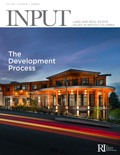Advancing the conversation on land and real estate issues in BC.
Insight: REIBC blog > Zoning for Sale?
Developers who seek zoning changes can expect to tackle the topic of community amenity contributions, or CACs, with the local government whose jurisdiction they are working in. CACs are used to support community amenities, such as daycares, community centres, and more, which could be stretched beyond their capacity to serve the public as density increases from a change in zoning.
Local governments in BC use three primary ways to calculate CACs, sometimes in combination. The CAC is a cost that must be accounted for in project planning, yet the amounts vary and the process can be cloudy, making financial planning difficult.
John McLachlan, Input's Ask a Lawyer columnist, describes some of the challenges: "Fixed-rate CACs … [provide] certainty in the amount … required but [lack] flexibility to adjust to changing market conditions or the particular circumstances of each development," while "the land lift approach bases the CAC contribution on a percentage of the increase in land value due to the rezoning … [but] the increase is generally based on the developer's pro forma and can be difficult to properly assess as many of the line items in the pro forma are debatable in terms of impact to the land value."
Private negotiations to determine CAC amounts perhaps offer the most flexibility, but this third approach can also be unpredictable since "inconsistency and subjectivity, with a large variance between projects" can occur.
CACs have grown over recent years, particularly in Vancouver. "In 2016," relates McLachlan, "the City of Vancouver obtained $127 million in cash or in-kind CACs from 51 rezoning and density bonus project approvals. Of that amount, $85 million came from just five rezoning approvals."
The Province of BC's CAC guide for local governments, Community Amenity Contributions: Balancing Community Planning, Public Benefits and Housing Affordability, reminds local governments that CACs (and rezoning) are intended to help with the implementation of official community plans rather than generate income.
 |
| Download Fall 2018 |
Read more about CAC calculations and the Province’s guide in McLachlan’s “Ask a Lawyer” column in the Fall 2018 edition of Input. Download Fall 2018
Join the conversation on Facebook
